WIYS: UK expat reveals highs and lows of Canadian hay business
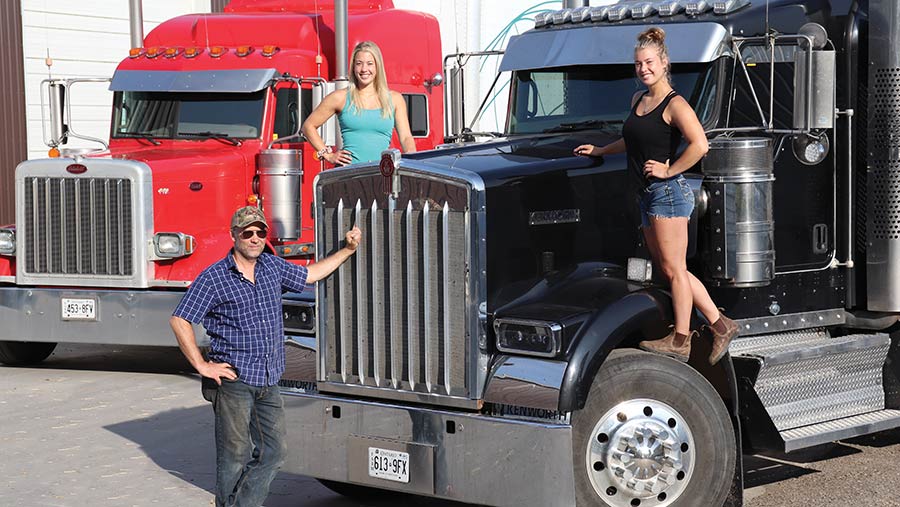 Mike Faulkner and his daughters Georgie and Emma with the Peterbilt (left) and Kenworth © Andrew Faulkner
Mike Faulkner and his daughters Georgie and Emma with the Peterbilt (left) and Kenworth © Andrew Faulkner Hay farmer and trader Mike Faulkner emigrated from the UK to Canada more than 20 years ago.
Yet even today most of his kit still has a European flavour.
Farmers Weekly asked Mike to talk us through his machinery fleet.
See also: Video: Retrofit Mojow tractor kit automates arable fieldwork
How did you get started?
Mine was the traditional route into farming – grew up on the family’s dairy/arable farm in Hampshire, went to Shuttleworth Agricultural College, returned home to run the 200-cow dairy herd, got married and had three children.
Then it all changed in 2000. Faced with a big capital investment to remain in dairying in the UK, we opted to sell the herd and milk quota, and my wife Jane and I, and our three children (Barney and twins Georgie and Emma), emigrated to Ontario, Canada, to a 60ha dairy farm.
New country, new home, new job, three children under the age of two… ‘Challenge’ doesn’t even come close.
Buying the farm and 55 cows as a going concern, we landed in the morning and, with a little guidance from the vendors, were milking in the afternoon.
Today, it’s a very different operation. The cows are long gone, replaced by an 18,000-bird laying enterprise managed under contract for a genetics company.
Alongside this, we trade as Fielders Farms Inc, growing hay, corn (grain maize) and soya beans on 130ha of owned ground and a further 225ha of rented/share-cropped land.
Cropping is four years of alfalfa/timothy, followed by break crops of corn, beans and wheat.
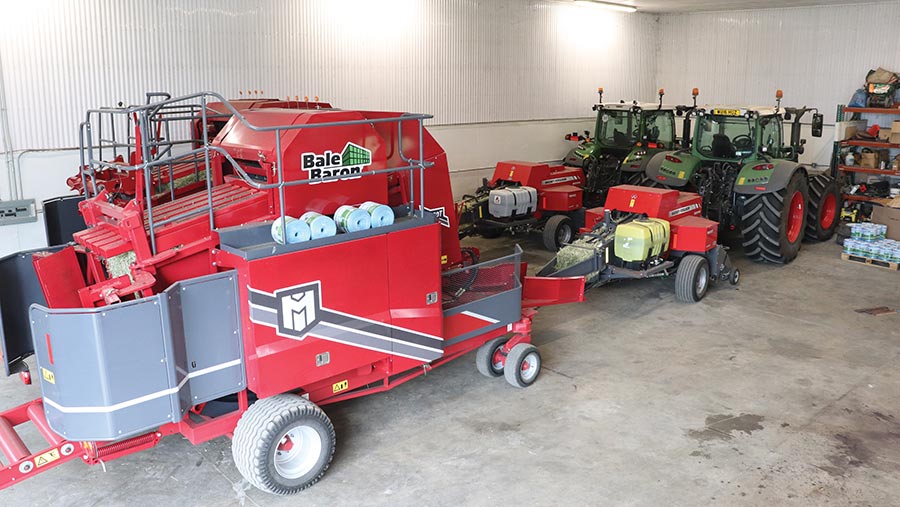
The heated workshop is home to the pair of MF inline balers and Bale Baron collectors © Andrew Faulkner
About 95% of the hay goes into little squares (21-bale Bale Baron bundles), and these are then shipped in trucks on a two-day trip down to Florida for the horse market – ponies, polo, racehorses, etc.
We send about 80,000 of our own bales every year plus another 200,000 from other Ontario growers, which are brought back to our yard for batching up ahead of shipment to the States.
Currently we use our own trucks to haul back to base from within Ontario and employ third-party hauliers for the Florida route.
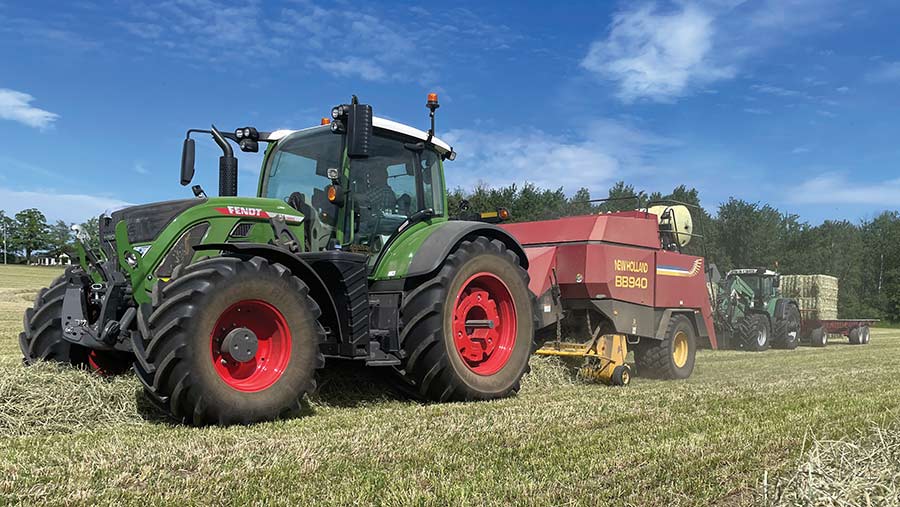
The farm’s 24-year-old New Holland BB940 bales straw and lower quality hay © Andrew Faulkner
As for making the hay, a typical first-cut sequence is to mow on day one, ted on day two and leave on day three.
On day four we ted for a final time, rake and bale. This clearly varies according to the crop and weather conditions.
Any crop that doesn’t make the Florida grade goes into big squares – about 500 a year.
How brand loyal are you?
It’s more about buying the best machine for the job. We’ve settled on in-line conventional balers, which makes the Massey the obvious choice.
These are paired with Bale Barons, and they again are the only practical option for producing the 21-bale bundles that suit our customers and maximise freight efficiency.
For handling, we’ve tried mini Manitou and Merlo telehandlers but prefer the JCB – we’re on our second one now.
Tractor-wise, we reckon there’s nothing to beat the Fendt Vario on the balers, where fine adjustment of forward speed is critical to optimising bale quality.
Farm facts: Fielders Farms, Rockwood, Ontario
- Farm size 130ha of owned land, 225ha rented/share-cropped
- Cropping Timothy grass/alfalfa, corn (grain maize), soya beans and a small area of winter wheat
- Stock 18,000 laying hens
- Soil type From “black muck” (dark sand) to clay loam
- Staff Mike Faulkner, daughters Georgie and Emma, plus Cornelio Goertzen (seasonal)
Favourite dealer?
Agco dealer Maple Lane Farm Services, at Mount Forest, tops our pile. They’re about a 45min drive away and have supplied us with most of our Fendt and MF kit.
On sales, there’s no bull and no haggling. You know where you stand.
Favourite piece of kit?
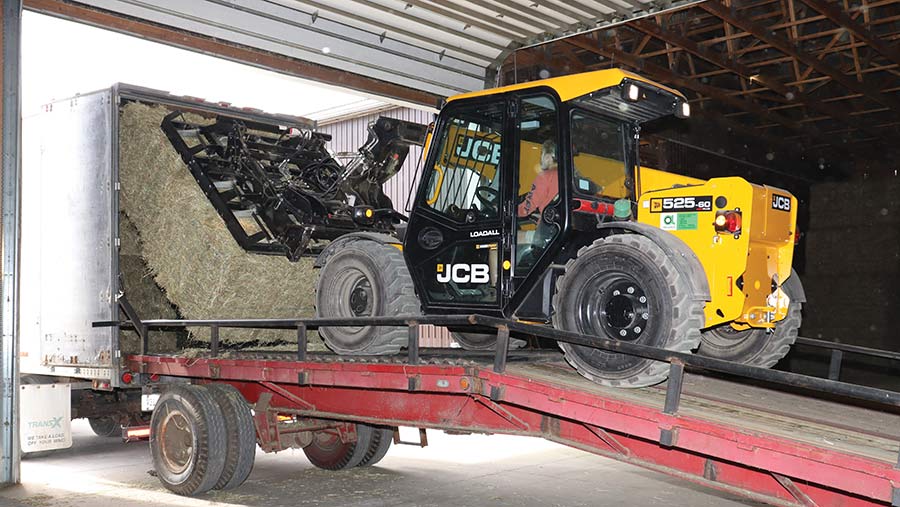
The JCB 525-60 loads bales into a box trailer. The handler measures 1890mm high and 1840mm wide © Andrew Faulkner
Probably the JCB 525-60 telehandler. Coupled with a Marcrest Claw 2.0 with offset, it picks up two 21-bale bundles at a time and places them four high in our sheds, offsetting the top two bundles to create a safer stack.
We also run up our home-built ramp to load the hauliers’ 53ft long box and refrigerated trailers when shipping to Florida.
It’s a neat handler combination – small enough to fit inside the box trailers and be nimble around the yard, yet powerful enough to do everything we need.
The only niggle is with its auto four-wheel steer alignment, which never seems to work quite as it should.
Least favourite piece of kit?
The MF 5613 tractor, though this is a little unfair. It’s no Fendt, but it’s comfortable enough to drive and a great raking tractor, as it fits snugly between the fluffed windrows in second cut.
However, it has caused us a bunch of problems, mainly down to AdBlue sensors, and we’re also on to our fourth set of assister rams – not good on an eight-year-old tractor.
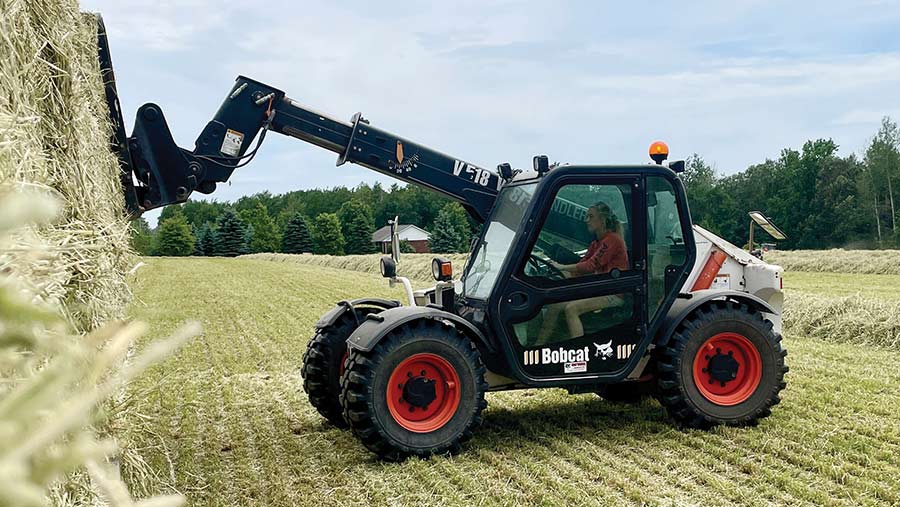
Back-up telehandler to the JCB Loadall 525-60 is a 15-year-old Bobcat V518 © Andrew Faulkner
Latest purchase?
We recently replaced a 10m Lely tedder with a 17m Pottinger HIT HT 17160, largely to achieve more output but also to give us a straight-tine alternative to the hook tines on the Lely.
When the alfalfa reaches a certain maturity and moisture content, the Lely’s hook ends tend to cling on to the crop.
When raked, this can result in lumpy, ropey windrows, which aren’t conducive to evenly made, top-quality hay.
The counter-argument for hook tines, however, is that in most conditions they do a better job of inverting the crop.
Oldest machine still at work?
That would be the 1970s Ford 5600, which runs the generator whenever the electric is down.
The tractor can go for months without being used, but invariably fires up first time when I turn the key.
How long do you keep your machines?
The only machines on a rigid turnover are the two conventional balers, which are swapped out on a four-season cycle.
The Bale Barons have far fewer wearing parts and are under less strain, so our way of mitigating the baling breakdown risk is to regularly change the relatively lower capital outlay balers.
As a comparison, a baler costs C$50,000 (£30,000), whereas a new Baron lists at C$120,000-plus (£71,500).
Previously, we ran Case IH side-pull balers, but two years ago we moved to MF 1840 in-line machines.
Although the side-pulls can be pushed for higher outputs, the in-line balers produce a more consistent bale shape and length, and they’re generally more forgiving in tougher conditions.
Uniform bale shape is critical when it comes to creating the neatest 21-bale Baron bundles. On flake number, we target our customers’ preference of seven to nine flakes/bale.
Other than the balers, most other machines are on a 10-year-plus cycle, and that includes the Barons.
Next on your wish list?
Top of a long list is a seeder on 5in (12.5cm) centres for planting alfalfa/timothy and wheat.
Our existing Deere 1590 no-till drill is on 7.5in (18cm) centres, so we end up cross-drilling to achieve tighter rows.
Going over the ground twice at 5mph with a 15ft (4.5m) drill is painfully slow. It would be good to find something like a used Vaderstad Rapid in decent shape.
Biggest machinery mistake?
Back in 2013 a previous employee managed to drive a swather over the headland, across a bank and into the bush before smacking its bed into a couple of trees.
Our suspicion is that he was either on his phone or had fallen asleep – the downside of auto-steer on a long run in the wrong hands.
The impact must have woken him up pretty sharpish, as he was doing 12mph at the time. The end-result was a C$45,000 (£27,000) insurance pay-out.
Smacking my wife’s Jeep into the Fendt 724’s front weight block last Christmas wasn’t my finest hour, either.
Most expensive repair bill?
Other than the swather incident, we spend a fair amount over the course of a year on the two trucks – a Kenworth W900 and Peterbilt 379.
We’re currently pricing up a major renovation on the 2007 Peterbilt, which is a pre-emissions model and has so far clocked in excess of 2m kilometres.
Cost is likely to be around C$150,000 (£90,000) for engine, bodywork and the like.
Most expensive spare part?
We’ve a couple of recent examples. Spending C$1,600 (£950) on 18ft of 6,000psi hydraulic hose for a dump trailer was painful, and, almost as unbelievable, we were quoted $1,200 (£715) for a replacement pto shaft guard for the Claas Liner 2800 rake.
After doing a bit of research we found an equally effective, after-market equivalent guard for $250 (£150).
Best invention?
We’re most proud of the mobile loading ramp, which started out as a 48ft flatbed trailer. We paid C$1,200 (£715) for it in 2016 and hauled it an hour and a half back from Niagara.
We chopped off two axles, re-boarded part of the floor and cut out a V to let the back-end drop. Then it was just a matter of tidying it up with side rails and an access ladder.
What couldn’t you live without in the farm workshop?
Cornelio Goertzen is the only non-family member of the team and works here from June to October before heading back home to Mexico.
He can turn his hand to most jobs in the workshop, and the previously mentioned loading ramp was his creation.
I also wouldn’t want to be without heat, as in winter the temperature drops as low as -30C – and that’s without the wind chill.
Conversely, the roof-mounted fans are effective in the summer, when the temperature and humidity can hit 35-40C and 95%, respectively.
Favourite and least favourite jobs?
Most satisfying is baling with the Barons when the job is going well – you’re confident that the crop is properly fit and you’re pumping out 48-50lb (22-23kg), sub-10% moisture bales into nicely shaped 1,050lb (475kg) 21-bale bundles.
Least favourite is anything to do with chicken muck, which is definitely a Bobcat job when it comes to clearing out the shed; we don’t let the JCB anywhere near the stuff.
The stink gets into everything: tyres, cabs, clothes.
Stone picking is another unpopular task – a spring-time job ahead of seeding down a new grass crop.
What’s your everyday farm transport?
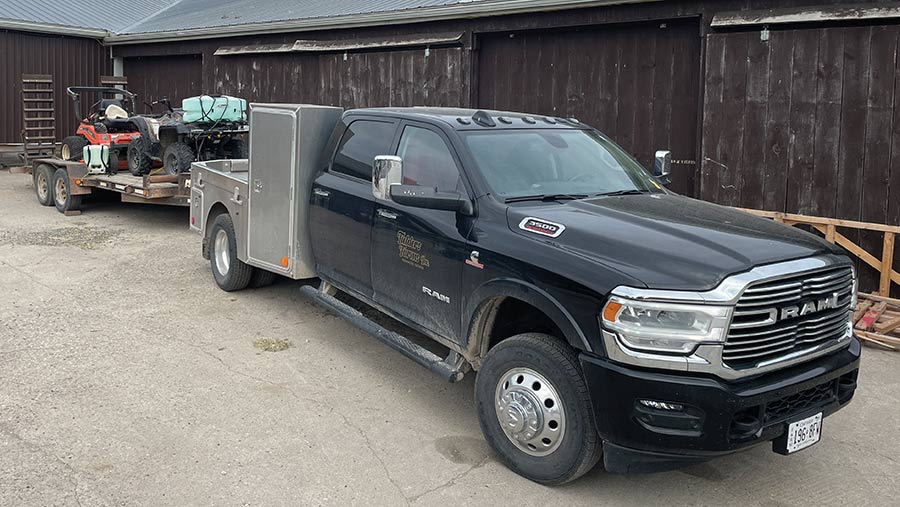
The V8, 6.7-litre Dodge service truck tows a 4.5t plant trailer © Andrew Faulkner
Everyone will jump in the Dodge Ram 3500 service truck, which has a custom-built aluminium bed including tool storage and a 350-litre diesel bowser for topping up machines when working away from home. It’ll also tow a 4.5t plant trailer.
I tend to use a 6.7-litre Cummins-powered Dodge Ram diesel double-cab, while Georgie and Emma run petrol trucks – a 5.3-litre GMC Sierra double-cab and 5.7-litre Dodge Ram single-cab.
Best tractor you’ve had?
That would have to be our Fendt 712. We bought it as a two-year-old in 2007 with 1,500 hours for C$95,000 (£56,600), and, today with 10,000 hours on the clock, it’s probably still worth around C$65,000 (£39,000).
It’s our experience with the 712 that gave us the confidence to invest in the second Fendt, a 724 that we imported from Richard Parris in the UK in 2018.
The exchange rate at the time meant the shipping cost of C$9,000-$9,500 (£5,400-£5,700) stacked up.
Worst tractor you’ve had?
The MF 5613, largely down to the niggling faults mentioned earlier – AdBlue sensors and assister rams.
Biggest machinery bargain?
We bought a cab-less MF 5455 loader tractor second-hand in 2012 for C$53,000 (£31,500) with 3,000 hours, and sold it 11 years later with 6,000 hours at $35,000 (£21,000). We spent pretty much nothing on it, too.
Best and worst pieces of technology on a machine?
I’m not a fan of emissions cleaning technology, which so far has caused us problems on the Massey 5613 tractor and one of the Dodge trucks.
My favourite piece of tech, other than auto-steer on the tractors and swathers, would be the DeltaForce coulter pressure control system on our Kinze planter. It’s remarkably effective.
In the shed
- Tractors Fendt 724 (x2), Fendt 516, Fendt 712 and Massey Ferguson 5613. All (bar one of the 724s) have front loader capability
- Combine John Deere 9500
- Telehandlers JCB Loadall 525-60 and Bobcat V518
- Drills John Deere 1590 no-till (alfalfa/timothy and wheat) and Kinze 3600 precision seeder (maize and soya beans)
- Mowers MF Hesston WR9970 and 9635 self-propelled swathers
- Balers MF 1840 inline and Bale Baron 5250T, MF 1840 inline and Bale Baron 4240T, New Holland BB940 big square
- Other hay kit Pottinger HIT HT 17160 tedder, Lely Lotus 1500 tedder, Claas Liner 2800 and 880 centre-delivery rakes, Tri-Sha Teddy Bear III fluffer
- Cultivation kit Case Tiger-Mate II cultivator, Lemken Heliodor 9 discs/press,
- Other kit Kenworth W900 truck, Peterbilt 379 truck, plus a selection of flatbed and box trailers. Horst wagon trailers (x4) for the ag tractors

